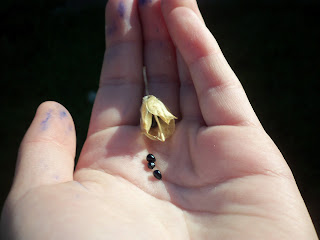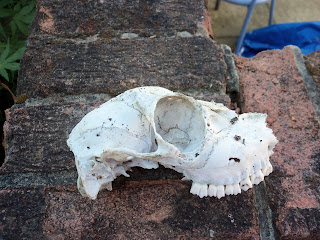There are two basic types of feeders. Mesh, and perspex tubes. The mesh ones are for peanuts, and the perspex tubes are for seeds. I will tell you more about feeders in Getting Started With Bird-Feeding 2. Although they are the most obvious option, and I must admit to using them, don't (or try not to) use seed mixes. These are wasteful, as birds (notably Greenfinches) are messy, picky eaters. Greenfinches search through the seed mix for sunflower seeds, throwing any other seeds out of the feeder onto your lawn. You can buy many seeds separately. Some of them are listed below:
These ones you can buy especially for birds:
Nyjer (Noug) - Long used by cage-bird keepers as a substitute for thistle seed, and now used for wild birds too.
Sunflower - Black and striped seeds are sold. Black are better as they are higher in energy. The flowers are very attractive to insects. Easily grown in your garden.
Barley - Used in seed mixes and sometimes sold on it's own. One of the most nutritious grains for birds. Similar to wheat.
Linseed (Flax) - Used in seed mixes and also sold on it's own. A high-energy food (500 calories/100g!!!!!)
Millet - Mainly used for seed mixes, some suppliers sell it on it's own. Rich in protein and iron.
Canary-Seed (Canarygrass) - Originally for cage-birds, but now increasingly for wild birds, it is high in unsaturated fat, oil, and protein.
Wheat - Similar to barley, and used as the main ingredient for many seed mixes. Highly nutritious.
Peanut - Very commonly sold for birds and humans. Highly nutritious. Beware of low-quality peanuts, as moulds such as aflatoxin are fatal to birds.
Maize (Corn-On-The-Cob) - Wholegrain,flaked and kibbled maize is sold for birds, all dried. The whole grains and flakes are eaten by pigeons and doves (and sometimes corvids [crow family]), and the smaller kibbled maize is eaten by much smaller birds. Good source of carbohydrate.
Many other grains, seeds, legumes and pulses can be bought for humans but used for birds:
Oats
Rape
Swede
Kale
Turnip
Hemp (Obviously the non-drug variety! lol)
Safflower
Quinoa
Pumpkin and other vegetables in the squash family
Buckwheat
Rice (Preferably raw brown rice)
Poppy (Blue Maw)
Sorghum (Milo)
Rye
Chick-Pea (Wood Pigeon heaven)
Coconut (if peanuts aren't available this will be the choice of tits)
Lentil
Mungbean (Green Gram)
Pea
Other nuts
All of these can be scattered on the ground or a bird-table, or put in a perspex tube feeder (or a homemade coke bottle one, or a bottle fitted with a commercially available bottle adaptor). The larger seeds can also be put in a mesh peanut tube. Specialist feeders for holding suet blocks or slices of bread can also be bought. Many variations of the basic mesh and perspex tubes exist, as do ones with predator-proof large mesh "cages" around the main feeder. Hang out as many feeders (with individual seed types in) as you in as many different places as you can, and the birds will come pouring in!
NEWS!!!
We have brewed the Elderflower champagne, and it is LUSH!!!
We have found that a hazel and a cherry tree growing outside the back gate that are already being stripped by birds and squirrels! We also found a whole row of plum trees somewhere... But we are keeping the location secret for now........
photos:
 |
| Cheery Tit Box (three holes and perches probably won't make the tits too happy) |
 |
| Ant Cocoon |
 |
| All-Important Berries |
 |
| Cornflower |
 |
| Feed the Ants, Feed the Green Woodpeckers! (Hopefully) |
 |
| Food on the Ground |
 |
| Pigeon Poo |
 |
| Bluebell Seeds |
 |
| Plants Grown From Bird Seed |
 |
| Eleanor Woodcock (Me) |
 |
| Can You Identify the Skull? I can't. |
 |
| Unripe Plums |
 |
| Waiting on the Wall with som "Photo Bait" |
No comments:
Post a Comment